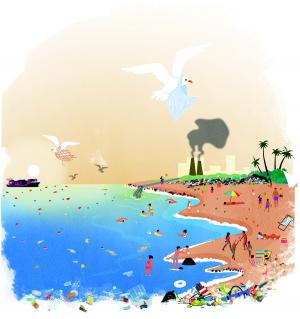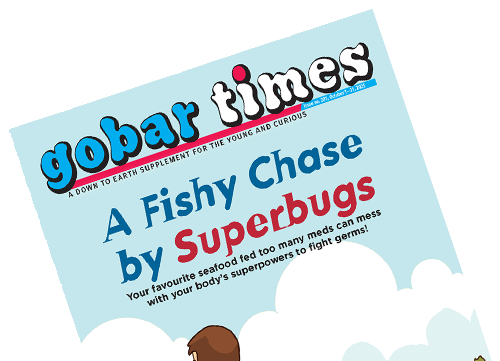
Explore how plastic, oil, chemicals, and even noise are choking marine life—and what we can do to help.

A glimpse from the ‘Gobar Times: Walk The Talk,’ a Fancy Dress Fun Fiesta organized as part of the Green Schools Carnival 2024 held on 30 January 2024 at the India Habitat Centre, New Delhi. All the fashionistas of the Gobar Times: Walk The Talk, showcasing their style quotient with chic aesthetics, inspired by the diverse covers of the Gobar Times (GT)! Through their understanding and vision of sustainability, these contestants imagined an out-of-the-box, ramp-worthy dress that triggered environmental consciousness among our audience...

A glimpse from the Gobar Times Design Studio, a designing contest organized as part of the Green Schools Carnival 2023, to allow our talented readers to express their vision and version of the Gobar Times by curating two-pages of the magazine—showing what they would like to read and how.

A look around any supermarket and one thing will be hard to miss: plastic. Every item small or big, from perishables to ones with a long shelf life is packed in plastic. Even the ones that have a covering of their own, say, oranges are needlessly packaged. The fruit is even peeled, kept on a delicate foam tray, and sealed with a plastic sheet. Apples are individually wrapped in comfortable cushions made of plastic. Gourds are packed in cling films. It’s almost as if humans think that their artificial packaging, which is wreaking havoc on the planet, is better than that of nature...

What are Micro-Plastics? Micro-plastics have not been defined in particular. They are just tiny particles that result from the disintegration of bigger plastic materials. However, most researchers say that any plastic smaller than 5 millimetres in size is a micro-plastic. Hence, these are really, really teeny-tiny! Plastics are made up of polymers, which are derived from fossil fuels. A whole lot of chemicals are added to the polymers—close to 10,000—to ensure that a given plastic has the desired properties...

How much can you put at stake to help Mother Earth? Do you think sustainability is a trend? This article answers these questions and peers into mending one’s lifestyle, beginning from the clothes that you buy. **************************** The environment is connected to almost every aspect of our lives, from what we eat and wear to the choices we make on a daily basis like taking the car or cycling down to the supermarket...

A resolution by Leaders to save humanity from drowning in ‘Plastic’. ******************************************* On March 2, 2022, representatives from over 200 countries gathered in Nairobi, Kenya for the continued fifth session of the United Nations Environment Assembly. The assembly then created history when 175 countries unanimously agreed on a United Nations framework to fight global plastic pollution from cradle to grave...

India has more than 1.5 million schools and 260 million students. Think about a regular day in these schools before the pandemic. Imagine the amount of waste— food waste, plastic, paper, stationery—produced in these schools in a day. Now, add COVID-19 waste to it as schools across the country are reopening. Imagine all of this waste going to landfills. Alarming, isn’t it?

To burst or not to burst?’ is a question many young humans might be asking as the patakha (firecracker) season begins. Teachers and doctors tend to advice against firecrackers but there’s always a paan-chewing uncle or a macho friend who’ll bully you kids into becoming enthusiastic arsonists. It’s usually a tough choice to make. Some additional information is always a good help in firming up ones’ resolutions. Therefore, let's throw some light on the history, chemistry, and eco-friendliness of patakhas.

The market today is flooded with bright, shiny toys and soft clothes for babies. But how is this related to microplastics in their feces? The market today is flooded with bright, shiny toys and soft clothes for babies. But how is this related to microplastics in their feces? Most products today like sipper cups, lunch boxes, baby bottles and wiping napkins are made of a substance called PET or polyethylene terephthalate. PET is taken from natural gas and crude oil. It is also another version of the polyester fabric...

